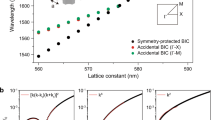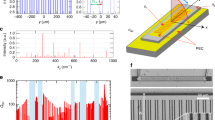Abstract
Metallic cavities can confine light to volumes with dimensions considerably smaller than the wavelength of light. It is commonly believed, however, that the high losses in metals are prohibitive for laser operation in small metallic cavities. Here we report for the first time laser operation in an electrically pumped metallic-coated nanocavity formed by a semiconductor heterostructure encapsulated in a thin gold film. The demonstrated lasers show a low threshold current and their dimensions are smaller than the smallest electrically pumped lasers reported so far. With dimensions comparable to state-of-the-art electronic transistors and operating at low power and high speed, they are a strong contender as basic elements in digital photonic very large-scale integration. Furthermore we demonstrate that metallic-coated nanocavities with modal volumes smaller than dielectric cavities can have moderate quality factors.
This is a preview of subscription content, access via your institution
Access options
Subscribe to this journal
Receive 12 print issues and online access
$209.00 per year
only $17.42 per issue
Buy this article
- Purchase on Springer Link
- Instant access to full article PDF
Prices may be subject to local taxes which are calculated during checkout





Similar content being viewed by others
References
Park, H. G. et al. Electrically driven single-cell photonic crystal laser. Science 305, 1444–1447 (2004).
Painter, O. et al. Two-dimensional photonic band-gap defect mode laser. Science 284, 1819–1821 (1999).
McCall, S. L., Levi, A. F. J., Slusher, R. E., Pearton, S. J. & Logan, R. A. Whispering-gallery mode microdisk lasers. Appl. Phys. Lett. 60, 289–291 (1992).
Scheuer, J., Green, W. M. J., DeRose, G. A. & Yariv, A. Lasing from a circular Bragg nanocavity with an ultrasmall modal volume. Appl. Phys. Lett. 86, 251101 (2005).
Nozaki, K. & Baba, T. Laser characteristics with ultimate-small modal volume in photonic crystal slab point-shift nanolasers. Appl. Phys. Lett. 88, 211101 (2006).
Ishii, S., Nakagawa, A. & Baba, T. Modal characteristics and bistability in twin microdisk photonic molecule lasers. IEEE J. Sel. Top. Quant. Electron. 12, 71–77 (2006).
Hill, M. T. et al. A fast low-power optical memory based on coupled micro-ring lasers. Nature 432, 206–208 (2004).
Maier, S. A. Effective mode volume of nanoscale plasmon cavities. Opt. Quant. Electron. 38, 257–267 (2006).
Taflove, A. & Hagness, S. C. Computational Electrodynamics, The Finite-Difference Time-Domain Method 2nd edn (Artech House, Boston, 2000).
Judkins, J. B. & Ziolkowski, R. W. Finite-difference time-domain modeling of nonperfectly conducting metallic thin-film gratings. J. Opt. Soc. Am. A 12, 1974–1983 (1995).
Theye, M. L. Investigation of the optical properties of Au by means of thin semitransparent films. Phys. Rev. B 2, 3060–3078 (1970).
Johnson, P. B. & Christy, R. W. Optical constants of the noble metals. Phys. Rev. B 6, 4370–4379 (1972).
Prade, B. & Vinet, J. Y. Guided optical waves in fibers with negative dielectric constant. J. Lightwave Technol. 12, 6–18 (1994).
Annino, G., Yashiro, H., Cassettari, M. & Martinelli, M. Properties of trapped electromagnetic modes in coupled waveguides. Phys. Rev. B 73, 125308 (2006).
Coccioli, R., Boroditsky, M., Kim, K. W., Rahmat-Samii, Y. & Yablonovitch, E. Smallest possible electromagnetic mode volume in a dielectric cavity. IEE Proc. Optoelectron. 145, 391–397 (1998).
Altug, H., Englund, D. & Vučković, J. Ultrafast photonic crystal nanocavity laser. Nature Phys. 2, 484–488 (2006).
Agrawal, G. P. & Dutta, N. K. Semiconductor Lasers 2nd edn (Van Nostrand Reinhold, New York, 1993).
Omar, M. Elementary Solid State Physics (Addison-Wesley, Massachusetts, 1975).
Lide, D. R. Handbook of Chemistry and Physics 25th edn (CRC, New York, 1996).
Englund D. et al. Controlling the spontaneous emission rate of single quantum dots in a two-dimensional photonic crystal. Phys. Rev. Lett. 95, 013904 (2005).
Fujita, M. & Baba, T. Ultrasmall and ultralow threshold GaInAsP–InP microdisk injection lasers: Design, fabrication, lasing characteristics and spontaneous emission factor. IEEE J. Sel. Top. Quant. Electron. 5, 673–681 (1999).
Hill, M. T. et al. Integrated two-state AWG-based multiwavelength laser. IEEE Photon. Technol. Lett. 17, 956–958 (2005).
Asada, M., Miyamoto, Y. & Suematsu, Y. Gain and the threshold of three-dimensional quantum-box lasers. IEEE J. Quant. Electron. QE-22, 1915–1921 (1986).
Slusher R. E. et al. Threshold characteristics of semiconductor microdisk lasers. Appl. Phys. Lett. 63, 1310–1312 (1993).
Chuang, S. L., O'Gorman, J. & Levi, A. F. J. Amplified spontaneous emission and carrier pinning in laser diodes. IEEE J. Quant. Electron. 29, 1631–1639 (1993).
Bjork, B., Karlsson, A. & Yamamoto, Y. On the linewidth of microcavity lasers. Appl. Phys. Lett. 60, 304–306 (1991).
Gerard, J.-M. & Gayral, B. Strong Purcell effect for InAs quantum boxes in three-dimensional solid state microcavities. J. Lightwave Technol. 17, 2089–2095 (1999).
Yablonovitch, E., Bhat, R., Zah, C. E., Gmitter, T. J. & Koza, M. A. Nearly ideal InP/In0.53Ga0.47As heterojunction regrowth on chemically prepared In0.53Ga0.47As surfaces. Appl. Phys. Lett. 60, 371–373 (1992).
Forchel, A., Menschig, A., Maile, B. E., Leier, H. & Germann, R. Transport and optical properties of semiconductor quantum wires. J. Vac. Sci. Technol. B 9, 444–450 (1991).
Zielinski, E., Schweizer, H. & Streubel, K. Excitonic transitions and exciton damping processes in InGaAs/InP. J. Appl. Phys. 59, 2196–2204 (1986).
Acknowledgements
This work was supported by the Netherlands Organisation for Scientific Research (NWO) through the NRC photonics grant (awarded to G.D.K., M.K.S. and J.H.W.). Y.H.L. would like to acknowledge support from NRL/GRL project. We thank D. Lenstra for his comments on the experimental results.
Author information
Authors and Affiliations
Contributions
M.T.H. discovered the nanolaser structures reported here and performed design, fabrication, characterization and manuscript preparation. Y.S.O., B.S., Y.Z., T.d.V., E.J.G. and M.K.S. contributed to process development. R.N., P.J.v.V. and F.W.M.v.O. were responsible for the epitaxial growth. Y.S.O., R.N., J.P.T. and H.d.W. contributed to studies on surface recombination. T.J.E assisted with characterization. Y.H.L. and S.H.K. contributed with expertise on nanolaser modelling. M.K.S. assisted with writing the manuscript.
Corresponding author
Supplementary information
Supplementary Information
Supplementary information (PDF 51 kb)
Rights and permissions
About this article
Cite this article
Hill, M., Oei, YS., Smalbrugge, B. et al. Lasing in metallic-coated nanocavities. Nature Photon 1, 589–594 (2007). https://doi.org/10.1038/nphoton.2007.171
Received:
Revised:
Accepted:
Published:
Issue Date:
DOI: https://doi.org/10.1038/nphoton.2007.171
This article is cited by
-
Ultra-low threshold lasing through phase front engineering via a metallic circular aperture
Nature Communications (2022)
-
Efficient Coupling in Transverse Strip Metal-Insulator-Metal Structure on Silicon-on-Insulator Layer Stack
Silicon (2022)
-
Metal–insulator–metal waveguides with lateral electrical pumping
Optical and Quantum Electronics (2021)
-
Ten years of spasers and plasmonic nanolasers
Light: Science & Applications (2020)
-
Realizing spin Hamiltonians in nanoscale active photonic lattices
Nature Materials (2020)



